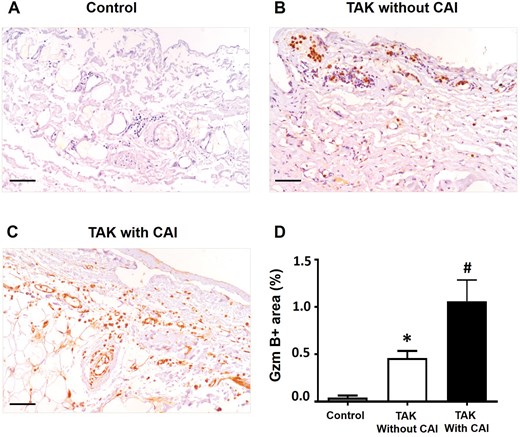-
Views
-
Cite
Cite
Taotao Li, Na Gao, Juan Du, Limin Zhao, Shiyu Yang, Yaxin Zhang, Junming Zhu, Haiou Hu, Zhiyu Qiao, Wei Cui, Lili Pan, CD8 cell-derived granzyme B may be a predictor for coronary artery involvement and MACE in Takayasu arteritis patients, Clinical and Experimental Immunology, Volume 219, Issue 1, 2025, uxae095, https://doi.org/10.1093/cei/uxae095
Close - Share Icon Share
Abstract
Coronary artery involvement (CAI) is a special but not rare manifestation of Takayasu arteritis (TAK). Granzyme B (GzmB) is a multifunctional protease associated with the immune system and coronary artery disease. However, its role in patients with TAK and CAI remains unclear. This study investigates the role of GzmB+ cell subsets in TAK. The study included 105 TAK patients and 58 healthy controls. The percentages of different GzmB+ cells in blood samples were analyzed by flow cytometry. We found that age, age at onset, body mass index, disease duration month, hypertension, and hyperlipidemia were significantly different between TAK patients with and without CAI (P = 0.000, P = 0.038, P = 0.003, P = 0.031, P = 0.039, P = 0.000). The proportions of CD3+CD8+cells (P = 0.001) and CD3+CD4+cells (P = 0.000) in GzmB+ cells were significantly increased, while the proportion of CD3-CD56+cells (P = 0.001) in GzmB+ cells was decreased in TAK patients. The proportions of three types of GzmB+ subsets in lymphocytes (CD3+CD4+GzmB+, CD3+CD8+GzmB+, CD3+CD56+ GzmB+) were higher in TAK patients with CAI compared with those without CAI (P = 0.021, P = 0.007, P = 0.007). The increased proportion of CD3+CD8+GzmB+cells/lymphocytes was an independent risk factor for coronary involvement in TAK (OR = 4.990 [1.766–14.098], P = 0.002). Additionally, patients with a high CD3+CD8+GzmB+cells/lymphocytes ratio had a higher major adverse cardiovascular events rate than those with a low ratio in TAK (P = 0.019). Our results indicate that CD8 cell-derived Gzm B may be a predictor for CAI and major adverse cardiovascular events in TAK patients. Targeting CD3+CD8+GzmB+ lymphocytes or using GzmB inhibitors could be a potential therapeutic approach for the treatment of CAI in TAK.






